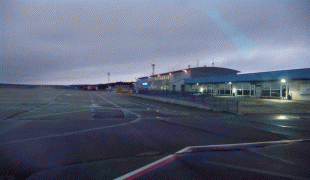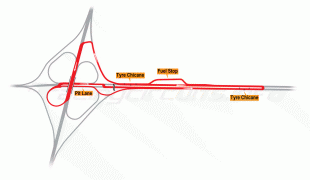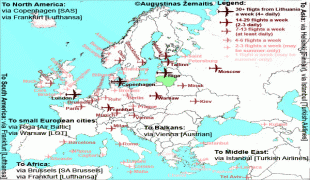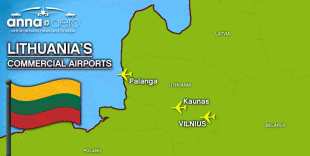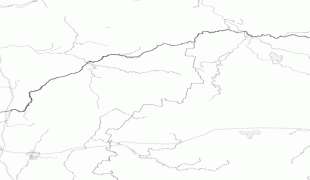Palanga International Airport (Palanga International Airport)
Palanga International Airport ( Tarptautinis Palangos oro uostas) is a regional international airport located near the resort town Palanga at the Baltic Sea. It is the third largest airport in Lithuania and focuses on short and mid-range routes to European destinations. It serves Lithuanian Baltic sea resorts of Palanga and the city of Klaipėda, and parts of Samogitia and western Latvia.
Palanga Airport started operations in 1937 at a site 7 kilometers East of the current terminal, near the Palanga-Darbėnai road. The Lithuanian Air Force pilots were trained there. In 1939, the first scheduled airline service in Lithuania began operating on Kaunas – Palanga route.
From 1940–1941, and again in 1945–1963, the airport was used by the Air Force of the Soviet Union. The new air strip and facilities at the current site first appeared during the post-World War II period. In 1963, the airport was converted to a civilian airport. In 1991, Palanga Airport was re-registered as a national airport owned and run by the state.
Since 1993, the number of passengers passing through the airport has been increasing annually. Between 1994 and 1997, the passenger terminal was renovated. Passenger services and luggage handling was modernized to comply with the requirements of the International Civil Aviation Organization (ICAO). Between 1994–1995, the flight control center was refurbished. In 1996–1997 the runway surface, and in 1998 the airport apron and taxiways were renovated. Since 1997, the airport joined the major international aviation organization ACI (Airports Council International).
After Lithuania became a member of the European Union, passengers in 2004 increased more than 60% in comparison with that of 2003.
Infrastructure improvements continued in 2007 with the construction of North terminal to expand the terminals' area by 2000 m2 as well as to comply with Schengen border crossing regimen. In June–October 2007 the runway 01/19 was expanded to 2280x45 meters along with installation of LIH (high intensity) lighting and embedding the runway centerline lights. The facility expansion completed in 2007 has made long-range route servicing a possibility. Over two hundred people are employed by the airport facilities.
Palanga Airport started operations in 1937 at a site 7 kilometers East of the current terminal, near the Palanga-Darbėnai road. The Lithuanian Air Force pilots were trained there. In 1939, the first scheduled airline service in Lithuania began operating on Kaunas – Palanga route.
From 1940–1941, and again in 1945–1963, the airport was used by the Air Force of the Soviet Union. The new air strip and facilities at the current site first appeared during the post-World War II period. In 1963, the airport was converted to a civilian airport. In 1991, Palanga Airport was re-registered as a national airport owned and run by the state.
Since 1993, the number of passengers passing through the airport has been increasing annually. Between 1994 and 1997, the passenger terminal was renovated. Passenger services and luggage handling was modernized to comply with the requirements of the International Civil Aviation Organization (ICAO). Between 1994–1995, the flight control center was refurbished. In 1996–1997 the runway surface, and in 1998 the airport apron and taxiways were renovated. Since 1997, the airport joined the major international aviation organization ACI (Airports Council International).
After Lithuania became a member of the European Union, passengers in 2004 increased more than 60% in comparison with that of 2003.
Infrastructure improvements continued in 2007 with the construction of North terminal to expand the terminals' area by 2000 m2 as well as to comply with Schengen border crossing regimen. In June–October 2007 the runway 01/19 was expanded to 2280x45 meters along with installation of LIH (high intensity) lighting and embedding the runway centerline lights. The facility expansion completed in 2007 has made long-range route servicing a possibility. Over two hundred people are employed by the airport facilities.
| IATA Code | PLQ | ICAO Code | EYPA | FAA Code | |
|---|---|---|---|---|---|
| Telephone | +370 460 5 20 20 | Fax | +370 460 5 20 20 | ||
| Home page | Hyperlink |
Map - Palanga International Airport (Palanga International Airport)
Map
Country - Lithuanian_Soviet_Socialist_Republic_(1918–1919)
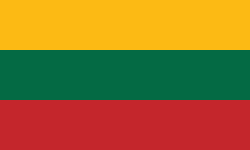 |
 |
| Flag of Lithuania | |
Germany had lost World War I and signed the Compiègne Armistice on 11 November 1918. Its military forces then started retreating from the former Ober Ost territories. Two days later, the government of the Soviet Russia renounced the Treaty of Brest-Litovsk, which had assured Lithuania's independence. Soviet forces then launched a westward offensive against Estonia, Latvia, Lithuania, Poland and Ukraine in an effort to spread the global proletarian revolution and replace national independence movements with Soviet republics. Their forces followed retreating German troops and reached Lithuania by the end of December 1918.
Currency / Language
| ISO | Currency | Symbol | Significant figures |
|---|---|---|---|
| EUR | Euro | € | 2 |
| ISO | Language |
|---|---|
| LT | Lithuanian language |
| PL | Polish language |
| RU | Russian language |








